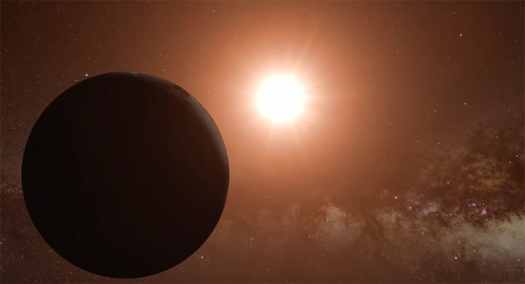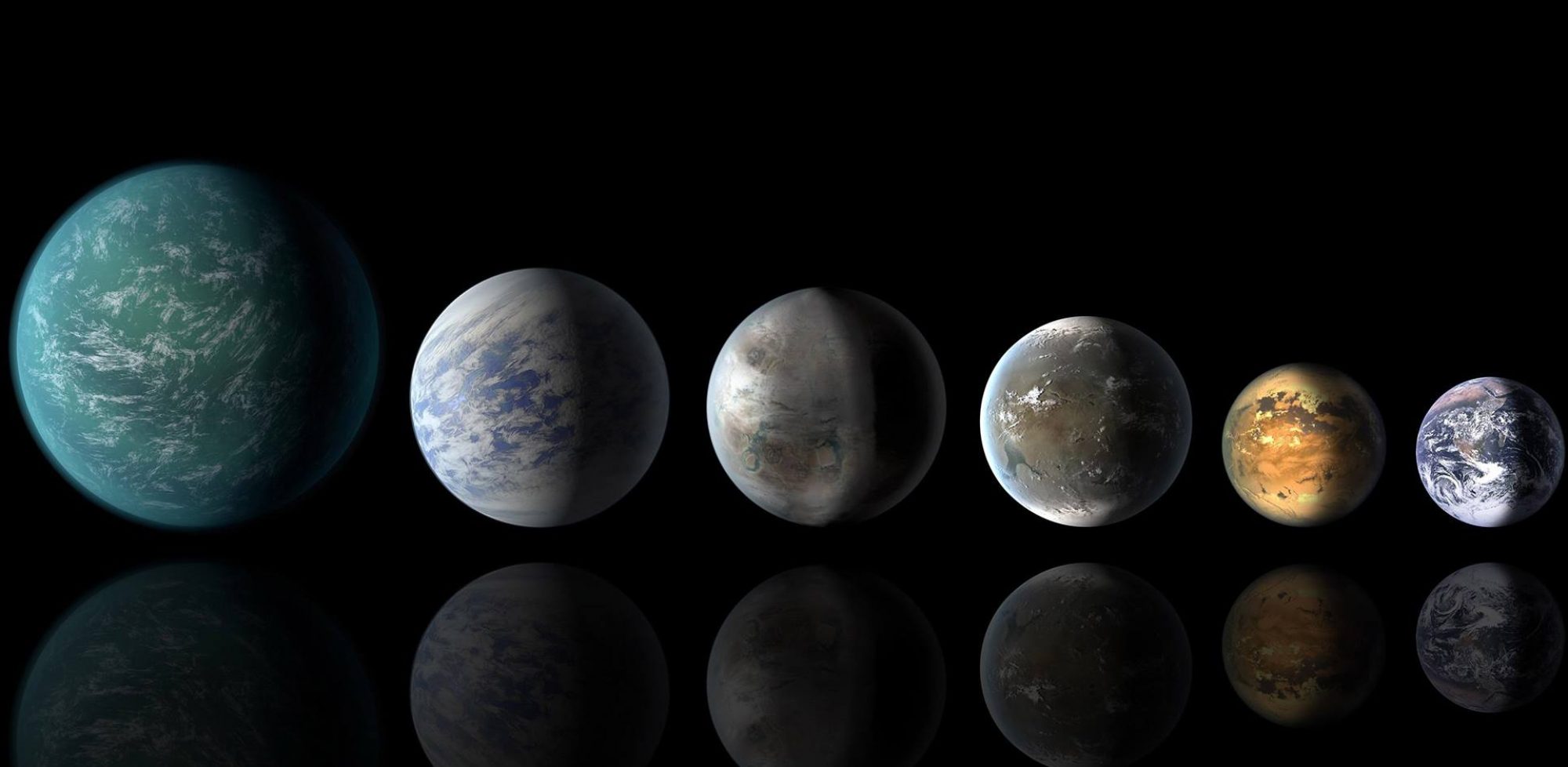
The more exoplanet scientists learn about the billions and billions of celestial bodies out there, the more the question of unusual planets — those with characteristics quite different from those in our solar system — has come into play.
Hot Jupiters, super-Earths, planets orbiting much smaller red dwarf stars — they are all grist for the exoplanet mill, for scientists trying to understand the planetary world that has exploded with possibilities and puzzles over the past two decades.
Another important category of planets unlike those we know are the loosely called “water worlds” (with very deep oceans) and their “aquaplanet” cousins (with a covering of water and continents) but orbiting stars very much unlike our sun.
Two recent papers address the central question of habitability in terms of these kind of planets — one with oceans and ice hundreds of miles deep, and one particular and compelling planet (Proxima Centauri b, the exoplanet closest to us) hypothesized to have water on its surface as it orbits a red dwarf star.
The question the papers address is whether these watery worlds might be habitable. The conclusions are based on modelling rather than observations, and they are both compelling and surprising.
In both cases — a planet with liquid H20 and ice many miles down, and another that probably faces its red dwarf sun all or most of the time — the answers from modelers is that yes, the planets could be habitable. That is very different from saying they are or even might be inhabited. Rather, the conclusions are based on computer models that take into account myriad conditions and come out with simulations about what kind of planets they might be.
This finding of potential watery-world habitability is no small matter because predictions of how planets form point to an abundance of water and ice in the planetesimals that grow into planets.
As described by Eric Ford, co-author of one of the papers and a professor of astrophysics at Pennsylvania State University, “Many scientists anticipate that planets with oceans much deeper than Earths could be a common outcome of planet formation. Indeed, one of the puzzling properties of Earth is that it has oceans that are just skin deep” compared to the radius of the planet.
“While some planets very close to their star might loose all their water, it would take a delicate balancing act to remove many ocean’s worth of water and to leave a planet with oceans as shallow as those on Earth.”
An interesting place to start.

It should first be said that many scientists are dubious that extreme water worlds can support life or can support detectable life. My colleague Elizabeth Tasker wrote a column — Can You Overwater a Planet? — focused on this view last year.
The first of the two new exoplanets/ocean papers involves planets with very deep oceans. Written by Edwin Kite of the University of Chicago and Ford of Penn State, the paper in the Astrophysical Journal concludes that even a planet with such super deep oceans could — under certain conditions — provide habitable conditions.
This finding is at odds with previous simulations, and Kite says that is part of its significance. The scientific community has largely assumed that planets covered in a deep ocean would not support the cycling of minerals and gases that keeps the climate stable on Earth, and thus wouldn’t be friendly to life.
But the Kite and Ford study found that ocean planets (with 10 to 1000 times as much water as Earth) could remain habitable much longer than previously assumed. The authors performed more than a thousand simulations to reach that conclusion.

“This really pushes back against the idea you need an Earth clone—that is, a planet with some land and a shallow ocean,” said Edwin Kite, assistant professor of geophysical sciences at the University of Chicago and lead author of the study.

Because life needs an extended period to evolve — and because the light and heat on planets can change as their stars age — scientists usually look for planets that have both some water and some way to keep their climates stable over time. The method for achieving this steady state that we know is, of course, how it works on Earth. Over eons, our planet has cooled itself by drawing down atmospheric greenhouse gases into minerals and warms itself up by releasing them via volcanoes.
But this model doesn’t work on a water world, with deep water covering the rock and suppressing volcanoes.
Kite and Ford wanted to know if there was another way to achieve a balance. They set up a simulation with thousands of randomly generated planets, and tracked the evolution of their climates over billions of years.
“The surprise was that many of them stay stable for more than a billion years, just by luck of the draw,” Kite said. “Our best guess is that it’s on the order of 10 percent of them.”
These planets sit in the right location around their stars. They happened to have the right amount of carbon present, and they don’t have too many minerals and elements from the crust dissolved in the oceans that would pull carbon out of the atmosphere. They have enough water from the start, and they cycle carbon between the atmosphere and ocean only, which in the right concentrations is sufficient to keep things stable.
None of this means that such a planet exists — our ability to detect oceans worlds is in its infancy. The issue is rather that Kite and Ford conclude that a deep ocean planet could potentially be habitable if other conditions were met.

Anthony Del Genio and his team of modelers at NASA’s Goddard Institute for Space Studies in New York used their state-of-the-art climate simulations to look at another aspect of the exoplanet water story, and they chose Proxima Centauri b as their subject. The roughly Earth-sized planet was discovered in 2016 and is the closest exoplanet to Earth.
Scientists determined early on that it is a rocky (as opposed to gaseous) planet and that it orbits its host star every 11 days. If that star was as powerful as our sun, there would be no talk of possible habitability on close-in Proxima b. But the star is a red dwarf and puts out only a fraction of the radiation coming from a host star like our sun.
Still, the case for habitability on Proxima b was initially considered to be weak, in part because the planet is tidally locked by its closeness to the host star. In other words, it would most likely not spin to create days and nights as it orbits, but rather would have a sun-facing side and a space-facing side — making the temperature differences great.
Our ability to characterize a small planet like Proxima b remains very limited, and so it is unknown whether the planet has water or whether it has an atmosphere. So those two essential components of the habitability question are missing.
But Del Genio’s team decided to model the dynamics of Proxima b with a presumed ocean, though not one that is many miles deep. In Earth science parlance, what Del Genio referred to as an “aquaplanet.” And using their sophisticated models, they would simulate “dynamic” oceans with currents like our own, rather than the stationary oceans modeled earlier on exoplanets.
And rather to their surprise, they reported in the journal Astrobiology that their model of ocean behavior showed that the planet would not have only small areas of potential habitability — the earlier proposed habitable “eyeball” scenario — but rather much of the planet could be habitable. That could include some of the normally space-facing side.

“Our group said let’s hook up an atmosphere to a dynamic ocean rather than a static one,” Del Genio said. “That way you get ocean currents like those on our coasts, and they move water of different temperatures around.
“If you have a real and dynamic ocean in your model, then we found that the eyeball goes away. Usually the currents go west to east and they carry warmer water even to the night side.”

So using this more sophisticated model, not insignificant areas of Proxima b, or any other planet like it orbiting a red dwarf star, could be habitable, they concluded. But again, that is assuming some pretty big “ifs” — the presence of an ocean and an atmosphere.
And then the team added variables such as a thick nitrogen and carbon atmosphere or a thin one, fresh water or salty water, a planet that is firmly locked and never rotating, or one that rotates a modest amount — giving the dark side some light. Del Genio said that with all these added factors, a substantial portion of the surface of Proxima b, or a planet like it, would have liquid water and potentially habitable conditions.
This focus on watery worlds — including those that would be extreme compared with Earth today — makes sense in the context of the history of Earth.
While there is no direct evidence of this, many scientists think that the very early Earth was covered for a period of time with water with little or no land.
And then after land appeared, it still took some three billion years for any life form — bacteria, early planets — to colonize the land, and another half billion years for animals to come ashore. Yet the oceans were long habitable and inhabited, as early a 3.8 billion years ago.
So until astronomy and exoplanet science develop the needed instruments and scientists acquire the observed knowledge of conditions on water worlds, progress will come largely from modelling that tells us what might be possible.
